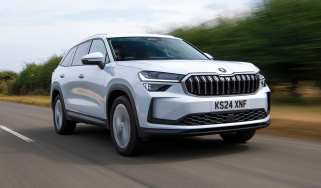New Skoda Kodiaq is here to solve all your family car problems
Skoda’s big seven-seat SUV has just been revealed in second-generation form. Can the Kodiaq stay ahead of the pack?
The Skoda Kodiaq is such a well-established model that it’s easy to forget it was only launched in 2016. Since then, the big SUV has bagged over 40 international awards and racked up more than 840,000 sales. Now Skoda hopes to give the model fresh impetus and attract a host of new customers with the second generation of Kodiaq, due on sale in UK dealers in early 2024.
It’s clear from the first glimpse at the Kodiaq that Skoda has taken an evolutionary approach to the design – as is often the case with the Czech brand’s best-known nameplates. At 4,758mm long, the new car is stretched slightly (61mm) compared with the outgoing Kodiaq, but the wheelbase is unchanged, at 2,791mm, so gains in accommodation space come in the third row of seven-seat editions and the boot. It remains on the VW Group’s proven MQB architecture.
Skoda says this Kodiaq introduces the first elements of the ‘Modern Solid’ design language that will guide the brand’s models into the second half of the decade. The front is instantly recognisable as a Kodiaq, though, with a fresh take on the split headlights and, optionally, illumination on the latest version of the company’s hexagonal grille – a feature introduced on the Skoda Enyaq EV. Matrix-LED lighting technology will also be available as an option.
The slight increase in overall size, and a very similar height to the outgoing car, haven’t stopped Skoda from improving the Kodiaq’s aerodynamic efficiency. In particular, design chief Oliver Stefani says that optimised air management for engine cooling – including ‘air curtains’ at the outer edges of the lower front bumper, and active shutters than can open and close to prioritise lower drag or airflow – has played a key role in reducing the car’s drag coefficient to Cd0.282.
There are fresh designs of more aero-efficient alloy wheels, and at the rear there’s a longer roof spoiler than before, positioned above a revised tailgate that features a fresh version of Skoda’s crystal-inspired tail-lights. The side profile has subtle surfacing on the doors and, notably, a contrast-colour D-pillar that’s presumably designed to help break up the metalwork along the flanks.
New Kodiaq chassis and engine range
The Kodiaq’s chassis is likely to have received only mild revisions, although there is the addition of DCC Plus Dynamic Chassis Control, which uses two-valve technology to control suspension rebound and compression (the outgoing car’s DCC had a single valve for both functions).
Skoda has shaken up the engine range, though, to incorporate mild-hybrid petrol and regular diesel options plus, for the first time on Kodiaq, a plug-in hybrid set-up. The range starts with a 1.5-litre TSI petrol producing 148bhp and using 48v mild-hybrid tech, and also features three 2.0-litre options: a 201bhp petrol that also gets mild-hybrid systems, plus cylinder deactivation, and two diesels with either 148bhp or 190bhp.
The most powerful petrol and diesel options are four-wheel drive, and regardless of engine choice, all Mk2 Kodiaqs come with an automatic dual-clutch transmission; there’s no manual option.
New plug-in hybrid model
Skoda has long ruled out the idea of a PHEV Kodiaq because it believed company-car choosers would always opt for a saloon or estate like the Octavia or Superb. But shifting market forces and gains in battery capacity have persuaded it to slot a plug-in hybrid into the range. It’s based on the base 148bhp 1.5 petrol engine but features an electric motor to help deliver a total output, through the front wheels and a six-speed dual-clutch gearbox, of 201bhp. It comes with 11kW AC and 50KW DC charging as standard.
The claimed pure-electric range for the Kodiaq PHEV is “more than 100km”; this should mean more than 60 miles, potentially dropping this Kodiaq into the eight-per cent Benefit-in-kind tax band for company-car choosers.
Interior design and technology
Inside, the front cabin is clearly influenced by the layout and design of Skoda’s all-electric Enyaq, with scope for cross-stitched leather panelling on the fascia itself, subtle metal highlights and curated combinations of materials and finishes to choose from.
The layout is dominated by Skoda’s latest infotainment system; the floating display measures 10 inches as standard, with a 13-inch system available as an option. There’s a 10-inch digital instrument panel and the option of a head-up display – and the car’s four USB-C connectors (two in the front, two in the rear) are rated at up to 45W, making them powerful enough to run laptop computers.
The Kodiaq also gets the same Smart Dials that will feature on the forthcoming new-gen Superb. Each of the three rotary controllers beneath the infotainment system contains a 32mm colour display showing the current function, with the outer pair controlling interior temperature, seat heating and seat ventilation. The middle two can cycle through volume for the audio system, air-con fan speed, driving modes and the zoom of the infotainment system’s map.
The new dials have allowed Skoda to clean up the front cabin while retaining physical controls for key functions. The gear selector has also been moved from the centre console to the steering column, freeing up yet more space in this area and allowing designers to add more than two litres of capacity to the central storage box.
Space and practicality
As a result of the modest stretch in overall length, Skoda claims that third-row passengers have a little more headroom, making the sixth and seventh seats more suitable for adults, while the boot capacities grow, regardless of seating configuration. Five-seat versions now have a capacity of 910 litres, growing to 2,105 litres with the second row folded down (40 litres more than in the Mk1 Kodiaq).
Seven-seaters, meanwhile, have 340 litres of boot space when all three rows are in place, rising to to 845 litres in five-seat mode (up 70 litres on the current layout) and an ultimate capacity of 2,035 litres when the second and third rows are folded away. The plug-in hybrid version, incidentally, is available as a five-seater only and its battery installation reduces the seats-up boot capacity to 745 litres.
Skoda has already confirmed that it will continue to offer the new Kodiaq in Sportline trim. This version gets a gloss-black finish on elements like the D-pillar, side-mirror caps, rear diffuser and badging, plus a different design and finish of 19-inch alloy wheels, with 20-inch items available as an option. Sportline should be available with all of the car’s powertrains, including the plug-in hybrid.
Price and on-sale date
The new Kodiaq is due on sale in February 2024, although first deliveries to UK customers aren’t expected until June. There’s no word yet on UK specs or prices, but given the slight increase in size and upgrade in cabin technology, we’d expect a small increase on the outgoing car’s figure. That could give the Mk2 Kodiaq a starting figure of around £35,000.
Click here for our list of the best 7-seater cars currently on sale...
Find a car with the experts











